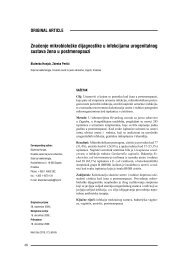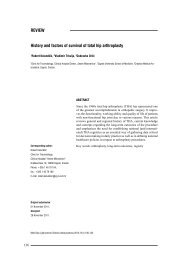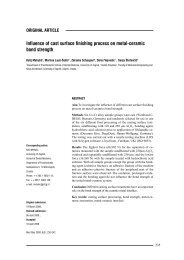MEDICINSKI GLASNIK - Aktuelno Ljekarska komora ZE - DO kantona
MEDICINSKI GLASNIK - Aktuelno Ljekarska komora ZE - DO kantona
MEDICINSKI GLASNIK - Aktuelno Ljekarska komora ZE - DO kantona
You also want an ePaper? Increase the reach of your titles
YUMPU automatically turns print PDFs into web optimized ePapers that Google loves.
20<br />
Medicinski Glasnik, Volumen 8, Number 1, February 2011<br />
INTRODUCTION<br />
In antenatal protection - monitoring growth and<br />
development of an unborn child, in most European<br />
countries it is recommended to perform three ultrasound<br />
scans: at 9 - 12, 19 - 22 and 29 - 32 weeks<br />
(1). In case of any abnormalities or complications<br />
of pregnancy, additional ultrasound scans could<br />
provide additional safety to pregnant women and<br />
gynecologists monitoring the pregnancy. In search<br />
for specific early ultrasound signs - markers that<br />
could indicate an increased risk of hereditary or<br />
acquired disorders (fetal chromosomopathies), scientific<br />
studies have confirmed an exceptional value<br />
of nuchal fold ultrasound findings (nuchal translucency,<br />
NT) (2). Nuchal fold scan measures fluid<br />
accumulation between the skin and subcutaneous<br />
fascia in the neck of an embryo. It is performed<br />
between 11 and 14 weeks of pregnancy, or when<br />
the crown- rump length (CRL) is 45 to 84 mm (3).<br />
Fold thickness of less than 99 percentile for CRL<br />
is usually tolerated (4). Numerous studies have<br />
shown association between ultrasound findings<br />
of nuchal fold > 3 mm and specific chromosomal<br />
aberrations, especially with aneuploidy and Down<br />
syndrome (5). The correlation of NT scan findings<br />
with Down syndrome is of such importance that<br />
most authors consider nuchal fold scan a screening<br />
procedure for Down syndrome (6). In the study of<br />
King’s group which was done at over 96,000 pregnancies<br />
(22 perinatal centers, 306 gynecologists)<br />
NT scan has indicated Down syndrome in 82%<br />
of fetuses (frequency of false positives: 8.3%)<br />
(7). In addition to association with chromosomal<br />
aberrations, nuchal fold thickness is also used as<br />
a marker for other genetic syndromes, usually heart<br />
anomalies (8). Fetal NT increases with CRL,<br />
therefore, it is very important to take into account<br />
gestation period when determining whether the<br />
measured NT was increased or not (9). In a study<br />
that involved 96,127 pregnancies, the NT median<br />
value and 95-percentile at a crown-rump length of<br />
45 mm were 1.2 and 2.1 mm; the respective values<br />
at a crown-rump length of 84 mm were 1.9 and 2.7<br />
mm (10). In pregnancies with fetal NT below the<br />
99th percentile (3.5 mm), parents’ decision regarding<br />
the determination of the fetal karyotype depended<br />
on the individual risk, accessed based on<br />
maternal age, ultrasound findings and free β-HCG<br />
and PAPP-A in maternal serum between 11-13 +6<br />
weeks (11).<br />
Several prospective interventional studies have<br />
examined implementation of NT screening into<br />
routine clinical practice (12). In our clinic in Kragujevac<br />
since 2008 we have reviewed nuchal fold<br />
thickness of fetuses in all pregnant women as an<br />
integral part of the review at the beginning of the<br />
second trimester of pregnancy. The resulting value<br />
was used to calculate the risk of using combined<br />
test. The aim of this study is to determine the<br />
predictive value of fetal NT measurements in the<br />
detection of chromosomopathy.<br />
PATIENTS AND METHODS<br />
The study was conducted at the Clinic for Gynecology<br />
and Obstetrics of the Clinical Center<br />
in Kragujevac (Serbia) on singleton intrauterine<br />
pregnancies in the first trimester of pregnancy<br />
in the period 2007-2009. A clinical experimental<br />
study model was used. All subjects read and<br />
signed informed consent for participation in this<br />
study. Ethical Committee of the Clinical Center<br />
Kragujevac approved the study.<br />
The investigation included 317 pregnant women<br />
with singleton pregnancies monitored by Genetic<br />
Counselling Service Committee of the Clinic<br />
of Gynaecology and Obstetrics of the Clinical<br />
Center Kragujevac. The study inclusion criteria<br />
involved the crown-rump length (CRL) between<br />
45 and 84 mm and the gestational age of 11-13+6<br />
weeks. For measurements of fetal nuchal translucency<br />
thickness (NT) a high-resolution ultrasound<br />
device Aloka Pro Sound 3500 with a cine-loop<br />
function was used, which allowed replay and<br />
a caliper providing measurements to 1 decimal<br />
point. Only the fetal head and the upper thorax<br />
were scanned. Since the magnification was maximal,<br />
each slight movement of the caliper produced<br />
only a 0.1 mm change. The nuchal translucency<br />
was measured with the fetus in a neutral<br />
position. The maximum thickness of the subcutaneous<br />
translucency between skin and the soft<br />
tissue overlying the cervical spine was measured.<br />
The calipers were placed on the lines defining<br />
the NT thickness so that they can hardly be seen<br />
on a white borderline behind the neck (Figure<br />
1). Several measurements during the scan were<br />
made, but only maximum measurement for the<br />
risk assessment was used. In cases where umbilical<br />
cord was around the fetal neck (in about 8%<br />
of the cases) the NT thickness above and below












